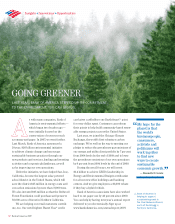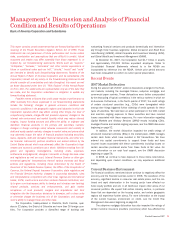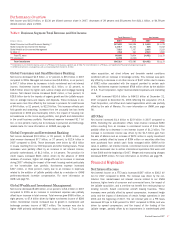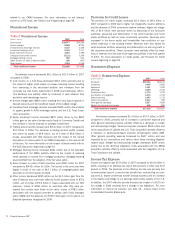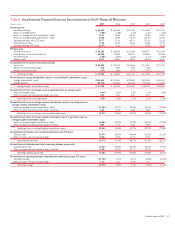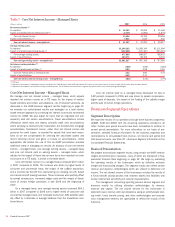Bank of America 2007 Annual Report Download - page 38
Download and view the complete annual report
Please find page 38 of the 2007 Bank of America annual report below. You can navigate through the pages in the report by either clicking on the pages listed below, or by using the keyword search tool below to find specific information within the annual report.pricing of certain municipal securities and the liquidity of the short term
public finance markets. We have direct and indirect exposure to monolines
and as a result are continuing to monitor this exposure as the markets
evolve. For more information related to our monoline exposure, see the
Industry Concentrations discussion on page 79.
The above conditions together with uncertainty in energy costs and
the overall economic slowdown, which may ultimately lead to recessionary
conditions, will affect other markets in which we do business and will
adversely impact our results in 2008. The degree of the impact is depend-
ent upon the duration and severity of the aforementioned conditions in this
rapidly changing business and interest rate environment. For more
information on interest rate sensitivity, see the Interest Rate Risk
Management for Nontrading Activities discussion on page 90.
Other Recent Events
In January 2008, we announced changes in our CMAS business within GCIB
which better align the strategy of this business with GCIB’s broader integrated
platform. We will continue to provide corporate, commercial and sponsored
clients with debt and equity capital raising services, strategic advice, and a
full range of corporate banking capabilities. However, we will reduce activities
in certain structured products (e.g., CDOs) and will resize the international
platform to emphasize debt, cash management, and selected trading serv-
ices, including rates and foreign exchange. This realignment will result in the
reduction of 650 front office personnel with additional infrastructure head-
count reduction to follow. We also plan to sell our equity prime brokerage
business. This is in addition to our announcement in October 2007 to elimi-
nate approximately 3,000 positions within various businesses, which includes
reductions in GCIB as part of our GCIB business strategic review to enhance
the operating platform, reductions in the wholesale mortgage-related business
included in GCSBB and reductions in other related infrastructure positions.
In August of 2007, we made a $2.0 billion investment in Countrywide
Financial Corporation (Countrywide), the largest mortgage lender in the
U.S., in the form of Series B non-voting convertible preferred securities
yielding 7.25 percent. In January 2008, we announced a definitive agree-
ment to purchase all outstanding shares of Countrywide for approximately
$4.0 billion in common stock. The acquisition would make us the nation’s
leading mortgage lender and loan servicer. The closing of this transaction
is subject to closing conditions and regulatory approvals and is expected
to close early in the third quarter of 2008.
In January 2008, the Board of Directors (the Board) declared a regu-
lar quarterly cash dividend on common stock of $0.64 per share, payable
on March 28, 2008 to common shareholders of record on March 7, 2008.
In October 2007, the Board declared a regular quarterly cash dividend on
common stock of $0.64 per share which was paid on December 28, 2007
to common shareholders of record on December 7, 2007. In July 2007,
the Board increased the quarterly cash dividend on common stock 14
percent from $0.56 to $0.64 per share.
In January 2008, we issued 240 thousand shares of Bank of America
Corporation Fixed-to-Floating Rate Non-Cumulative Preferred Stock, Series
K with a par value of $0.01 per share for $6.0 billion. The fixed rate is
8.00 percent through January 29, 2018 and then adjusts to three-month
LIBOR plus 363 basis points (bps) thereafter. In addition, we issued
6.9 million shares of Bank of America Corporation 7.25% Non-Cumulative
Perpetual Convertible Preferred Stock, Series L with a par value of
$0.01 per share for $6.9 billion. In November and December of 2007, we
issued 41 thousand shares of Bank of America Corporation 7.25%
Non-Cumulative Preferred Stock, Series J with a par value of $0.01 per
share for $1.0 billion. In September 2007, we issued 22 thousand shares
of Bank of America Corporation 6.625% Non-Cumulative Preferred Stock,
Series I with a par value of $0.01 per share for $550 million.
In December 2007, we completed the sale of Marsico Capital Man-
agement, LLC (Marsico), a 100 percent owned investment manager, to
Thomas F. Marsico, founder and chief executive officer of Marsico, and
realized a pre-tax gain of approximately $1.5 billion.
Merger Overview
On October 1, 2007, we acquired all the outstanding shares of ABN AMRO
North America Holding Company, parent of LaSalle Bank Corporation
(LaSalle), for $21.0 billion in cash. With this acquisition, we significantly
expanded our presence in metropolitan Chicago, Illinois and Michigan, by
adding LaSalle’s commercial banking clients, retail customers and banking
centers.
On July 1, 2007, we acquired all the outstanding shares of U.S. Trust
Corporation for $3.3 billion in cash. U.S. Trust Corporation focuses
exclusively on managing wealth for high net-worth and ultra high net-worth
individuals and families. The acquisition significantly increases the size and
capabilities of our wealth management business and positions it as one of
the largest financial services companies managing private wealth in the U.S.
On January 1, 2006, we acquired 100 percent of the outstanding
stock of MBNA Corporation (MBNA) for $34.6 billion. The acquisition
expanded our customer base and opportunity to deepen customer
relationships across the full breadth of the Corporation by delivering
innovative deposit, lending and investment products and services to
MBNA’s customer base. Additionally, the acquisition allowed us to sig-
nificantly increase our affinity relationships through MBNA’s credit card
operations and sell these credit cards through our delivery channels includ-
ing the retail branch network.
For more information related to these mergers, see Note 2 – Merger
and Restructuring Activity to the Corporation’s Consolidated Financial
Statements.
2007 Economic Overview
In 2007, notwithstanding significant declines in housing, soaring oil prices
and tremendous turmoil in financial markets, real Gross Domestic Product
(GDP) grew 2.2 percent. Growth softened significantly in the fourth quarter.
Consumer spending remained resilient, as increases in employment and
wages offset the negative influences of declining home prices. Fueled by
another year of strong exports and a slowdown in imports, the U.S. trade
deficit fell sharply, lifting U.S. domestic production. However, declines in
residential construction subtracted nearly a full percentage point from GDP
growth, more than offsetting the boost provided by international trade.
Corporate profits declined modestly in the second half of the year from
all-time record highs. Global economies recorded their fourth consecutive
year of rapid expansion, driven by sustained robust growth in China, India
and other emerging market economies. Growth in Europe and Japan mod-
erated in the second half of the year. Higher energy prices pushed up
inflation throughout the year. However, excluding food and energy, core
inflation receded in the second half of the year, in lagged response to the
deceleration of nominal spending growth. A sharp rise in defaults on sub-
prime mortgages and worries about the potential fallout from the faltering
housing and subprime mortgage markets triggered financial market turbu-
lence beginning in the summer. A dramatic repricing of credit risk and
unprecedented capital losses stemming from sharp declines in the value
of structured credit products based on subprime debt deepened the finan-
cial crisis. In response, the FRB eased short-term interest rates, reduced
the discount rate relative to its federal funds rate target and in December
created a new facility for auctioning short-term funds through the discount
window of the Federal Reserve Banks. The fourth quarter ended on a weak
note, as consumer spending moderated, businesses reduced production,
employment slowed and the unemployment rate rose.
36
Bank of America 2007








